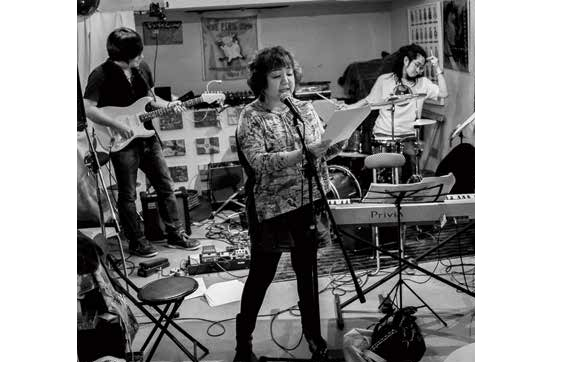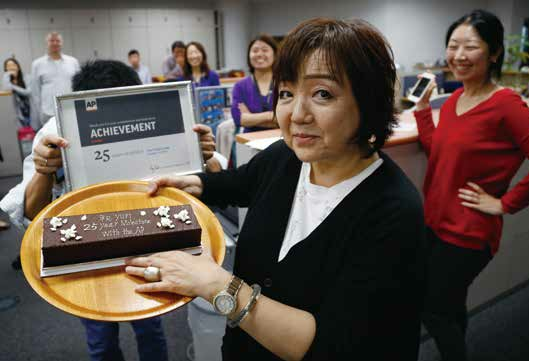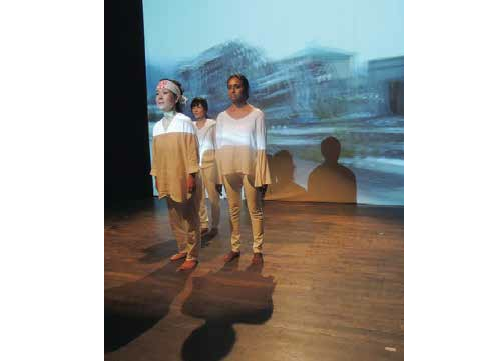Issue:
A veteran AP reporter reflects on creative passion and the poetics of journalism.

It is human duty to perform this act regularly, like a religious ritual, in homage, in honor, to give thanks, no matter its futility,” writes Yuri Kageyama. She’s writing about sex specifically menopause sex in the middle of a short story about her family. The prose is unvarnished, unflinchingly personal and adroit in quickly juggling themes of child abuse, racism and sexuality while maintaining a narrative flow.
Japan watchers and reporters in Tokyo may be familiar with Kageyama from seeing her at press conferences and reading her stories or her updates on Twitter, where she has more than 20,000 followers. She’s a veteran reporter who has been with Associated Press in Tokyo and the U.S. for 25 years. Her recent articles have covered everything from Takashi Murakami’s latest pop art creations to electronics giant Toshiba’s damaging accounting scandal and Tokyo Electric Power’s struggle to dismantle the crippled Fukushima Dai-ichi nuclear power plant as well as the campaign by Japanese activists to allow married couples to have different surnames.
That versatility is also manifest in her creative side. Published in 2009, the short story “The Father and the Son” reflects one of the many facets of Kageyama as a creative writer. She has published two books of poetry and prose and her work has been included in literary journals and websites.
“I became a writer because I want to be honorable,” Kageyama says at a cafe in Shiodome, home to the AP’s Tokyo bureau. “I want to do beautiful things and live my life in a way that is meaningful. I became a journalist because I like to write and that was one way you could get paid.”
Serendipity knocks
Kageyama is also a self-described novice filmmaker and a performance artist who draws upon her background and experiences living in two cultures. Born in Aichi Prefecture, Kageyama grew up in Tokyo, Maryland and Huntsville, Alabama, where her father, an engineer, worked on NASA’s Apollo program, which landed Neil Armstrong and Buzz Aldrin on the moon in 1969. While studying sociology in the 1970s at the University of California at Berkeley, she got her start in journalism by writing articles for community newspapers. One of her professors urged her to pursue a career in news, persuading her that the prospects were better than academia and that journalism is a form of sociology anyway. Then a serendipitous event sealed her destiny. When she was job hunting in Japan in the mid-eighties, she went to the Japan Times office to get a copy of the classifieds to look through the help-wanted ads.
“I walked in and told the subscriptions desk that I needed the ad section,” Kageyama recalls. “And then the managing editor walked up and said, ‘Why don’t you just work here?’”
It was the easiest job interview ever especially since she hadn’t even submitted her resume. At the Japan Times, she was in charge of putting out the weekly edition and then worked in the general news department, doing everything from reporting to captions to layout. In 1990, she joined the AP and has since produced investigative reports, such as a 2012 story showing that scientists who helped determine radiation exposure limits in Japan accepted trips paid for by Japanese nuclear plant operators. A 2014 article, written with Richard Lardner and based on Freedom of Information Act requests, uncovered questionable handling of sexual abuse cases among U.S. military personnel serving in Japan. The story added fuel to a campaign to change the way sexual assault cases are prosecuted by commanders.
Rock me like a Yuricane
While at UC Berkeley, Kageyama met her mentor Ishmael Reed, an author and educator who published her first poem, “A Song for the Big White Bitch.” Reed later compared the raw power of her writing to a hurricane, and dubbed her the Yuricane, which is now the name of her spoken word and world music band. With titles like “Little YELLOW Slut,” “Assumptions” and “an ode to the Caucasian male,” Kageyama’s poems have addressed stereotypes about race and gender roles. They’re made even more powerful when Kageyama recites them with collaborators such as Ghanaian percussionist Winchester Nii Tete on African drums and Keiji Kubo on didgeridoo. Against the backdrop of a traditional Noh stage, it’s a heady, globalized mix of words and music, especially when the topic is making love to younger men.
Kageyama’s “News From Fukushima” is a multilayered dance, music and spoken-word piece that was staged at New York’s La MaMa Experimental Theater in September 2015. It’s one example of a subject that Kageyama has explored both as an artist and journalist, having spent many days covering press conferences at Tokyo Electric Power’s office after the March 11, 2011 cataclysm and later visiting the disaster zone; it also incorporates elements of racism, sexism and abortion as well as friendship between women.
“I always felt that literature was superior to journalism that it took more talent to write a real poem than an article,” Kageyama says, “but when the disaster happened, I realized how powerless poetry can be, and that people need journalism in the wake of a disaster. When Fukushima happened, I realized it was the story of my life.”
Switching from an objective, fact-oriented writing approach for an AP story (while observing AP style, of course) and then going home to write a free-form poem or essay about the same topic, yet with a deeply personal angle, has never been a problem for Kageyama. For instance, she has writ-ten both articles and a poem about Kenji Goto, the Japanese video journalist beheaded by Islamic State militants in January 2015.
“You have all of this emotion, and you contain that to do the AP story what are you going to do with all the emotion that’s left?” she asks. “It has to come out in some way. Then I have to write a poem. By being engaged in the world, your poems are certainly going to be better.”
Wearing many hats
Kageyama’s lyrics were recently highlighted in “I Will Bleed,” a song she wrote with Indian singer-songwriter Trupti Pandkar that was inspired by Chikamatsu’s Sonezaki Shinju, the famous bunraku puppet play about love suicides. It speaks of crossing boundaries, with lines such as “Not afraid of different tongues/Our blood joined will make us one. ” The slow, soulful tune was a finalist in the R&B category in the 2015 UK Songwriting Contest and will be included on a forthcoming CD that Kageyama, Trupti and bassist Hiroshi Tokieda are working on. Meanwhile, Kageyama is trying to get her Fukushima piece staged in another city and has a children’s book in the works with an illustrator. She’s determined to keep up her creative output despite the demands of her reporting job and will continue to draw inspiration from news events and collaborations with other artists.
“I’m not that inhibited about what art is or where borders lie, because my life has been about defying borders, so I don’t think that there’s such a thing as what is proper,” Kageyama says. “I’m not writing to please anybody. I think rules are there to be broken and you cross the borders and you see what happens. That’s one of the better things we have going in life."


Poem for Kenji Goto, a journalist, Feb. 1, 2015
by Yuri Kageyama
i have already written about you another journalistyour story as a hostagesomewhere far awayin a wind-blowing desertyour story abouthow it all endedtodayi do not know youbut i have to write somethingelse for youthis poemit just doesn’t seem rightunless i dopeople say you caredyou were great to work withyou will live on in our heartsyou laugh in your own videos“No matter what happens to me,”you say before you leave,“I will always love the people of Syria.” you are calmyou look straight into the camerayou are gentle in your deathyou are brave in your deathi just have to write thisin even that videoyou are beautiful
Tim Hornyak is a freelance writer who has worked for IDG News, CNET News, Lonely Planet and other media. He is the author of Loving the Machine: The Art and Science of Japanese Robots.

